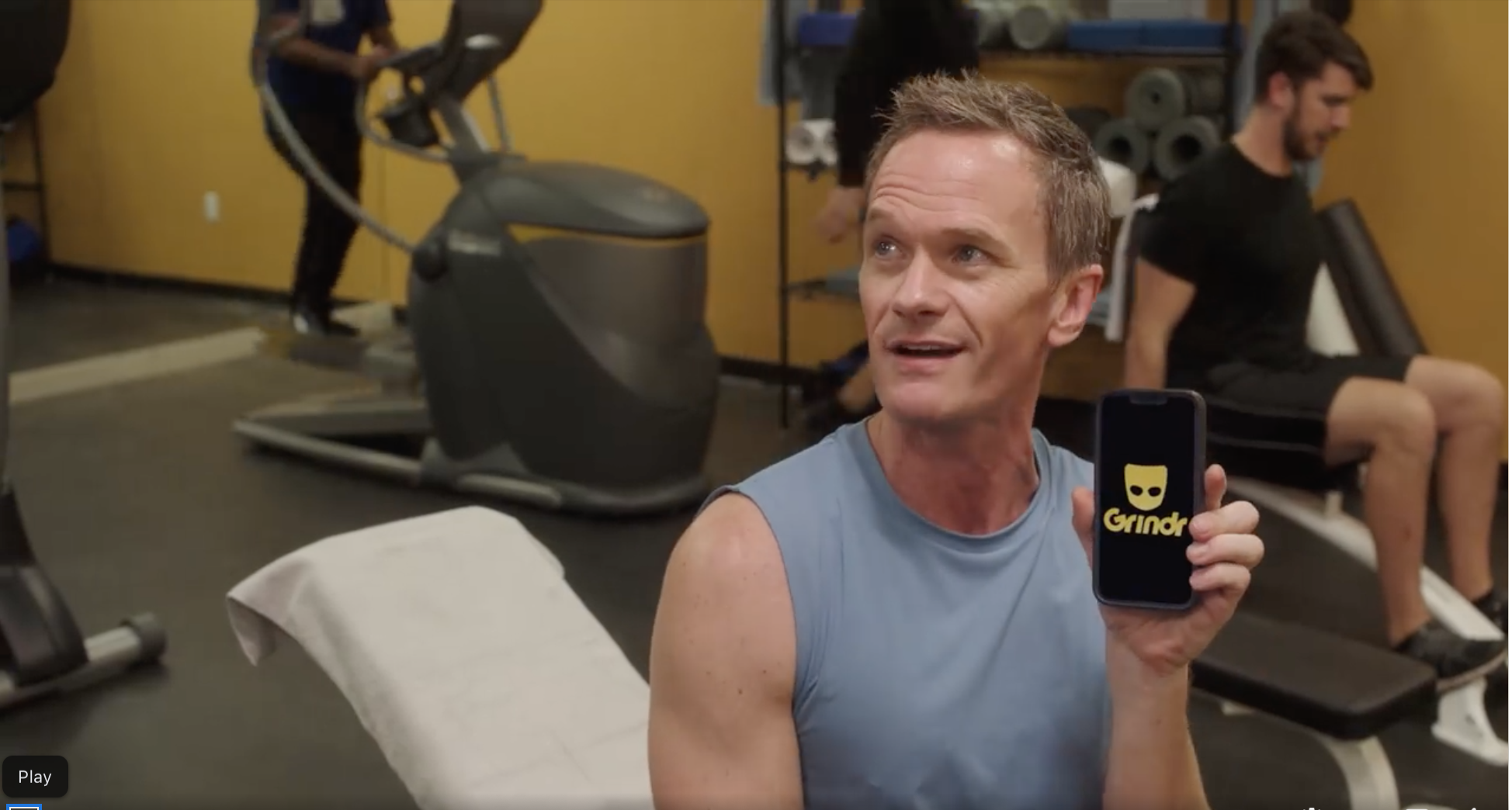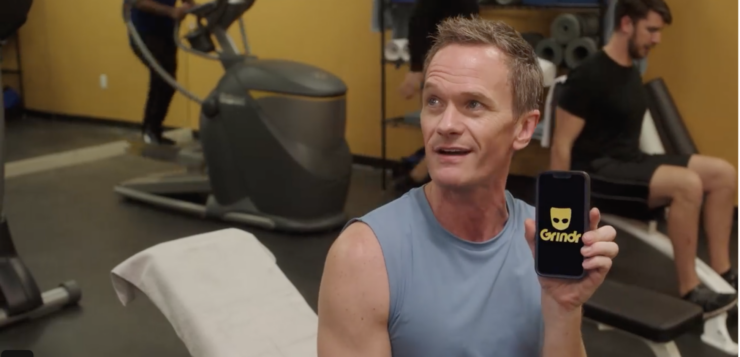
IN THE EVENT that you missed last year’s Netflix release Uncoupled, the eight-part series followed the life of Michael, a forty-something gay man played by Neil Patrick Harris, as he navigates the world of gay dating in New York City following the unexpected departure of his partner of seventeen years (Colin, played by Tuc Watkins). This brave gay world includes PrEP and “dick pics,” which are all but unknown to the show’s protagonist. In addition to HIV prophylaxis and virtual penises, Michael downloads the requisite app for single (and some coupled) gay men like himself: good old Grindr. Michael is now “out there,” so he goes to a gay club with friends, who inform him that many of the patrons on the dance floor are simultaneously on Grindr. “Why are they on Grindr when they’re right next to us?” Michael inquires. A friend assures him that “this is how you meet people now. You’ve been away a long time, Rip Van Winkle.”
Grindr, now fourteen years old, has become a mainstay smartphone app for members of the queer community, and a virtual landscape for gay men and queer people to interact in, as well as to find hookups. Having been on Grindr myself for some time, I’m struck by how its users, myself included, live a portion of our lives on the app, in a world of faces, anonymous chests, and stock photos in small squares forming a grid. In any case, it’s a very different world from that of gay bars, bathhouses, and cruising parks, not to mention gay neighborhoods where clubs, pubs, apartments, and condos are teeming with queens, twinks, and bears, to name a few subgroups. Not that the bricks-and-mortar gay world has entirely disappeared, as witness Uncoupled; and the two worlds can indeed coexist. I can remember chatting with gay friends in Boystown about who was in the bars and what we knew about them from their profiles on the app. Grindr is a queer space in its own right, but it also influences the dynamic of these physical spaces.
Queer people have long been associated with the city. In his 2005 book In a Queer Time and Place: Transgender Bodies, Subcultural Lives, Jack Halberstam refers to a habit of “metronormativity” such that gay life in the big city tends to completely overshadow queer people living outside of the metropolis. Coming from a nonurban area of Kansas, and being a Grindr and Scruff user myself, the concept of metronormativity rang true, and I began to wonder how these apps might function in less populated places, and how that may differ from the urban gay worlds like those of Uncoupled. Clearly rural spaces don’t have the queer population density, the culture of “outness,” or the explicitly LGBT spaces, especially ones that are fixtures, that the metropolis has. But they do have Grindr and Scruff.
That is why, in 2019, I conducted interviews over Grindr and Scruff with eleven nonmetropolitan users of these apps in the Midwest to learn about the virtual queer landscapes present in those spaces and places. Much research on apps such as these frames them as hookup apps—essentially a means to an end—but I took a different approach in my interviews, framing Grindr and Scruff as spaces in their own right. In fact, the two apps represent separate spaces that users recognize as such. While Grindr is generally seen as primarily a pick-up app, Scruff caters to social needs other than sex. One user explained that “Grindr felt very impersonal and overly sexual. … Scruff has many guys like that, but tends more towards men willing to show their faces and looking for more serious relationships.”
Anonymity and Authenticity
Discretion, anonymity, and secrecy have haunted queer history, giving rise to everything from nighttime cruising areas to the wearing of a colored bandana on the street. This mindset has found its way into Grindr and Scruff with so-called “discreet” users. Among those I interviewed, anonymity on Grindr and Scruff became a complicated discussion about authenticity, outness, and the closet—concerns of special interest in the conservative, nonurban Midwest.
One user felt they had honest intentions using the app and measured this by presenting themself online as they would in person. Whether or not a user’s Grindr persona matches who they are in person is a frequent question for anyone who meets people this way. One person mentioned meeting up with a user whose aggressively sexual online persona was a mismatch when they ended up being quiet and shy in person. Another said that they knew people from in-person interactions who would not interact with them on Grindr (who knows why?). Yet another mentioned that people on Grindr can be crueler than they probably would be in person—a well-known casualty of online interaction of all kinds.
One reason for being anonymous on Grindr is the fear of being outed. This can be a special concern in nonurban or rural areas: some respondents referred to the precautions they take to avoid being identified. But there are other reasons to be anonymous on Grindr. Two users observed that anonymity gives users greater freedom to explore sexual fantasies and the like than they would otherwise have. A user who described their area as “sheltered and traditional” suggested that anonymity allows for “more convos and sexual encounters” (especially in a place where there’s a fear of being outed).
And if that were not enough, anonymity has the benefit of disavowing accountability for one’s behavior on the app. However, this “benefit” can be a detriment for other users. Two users described being harassed for their physical appearance online, and they blamed anonymity for allowing this. One of them detailed a scenario involving an organized hook-up that fell through, and pondered how people cling to anonymity at the expense of real-life experience: “I feel like some of them may never have explored their sexualitiies if they weren’t able to do so anonymously via an online dating/hookup app. It’s similar to how the asshole guy felt like he could fat shame me. It’s easy to do those things when you aren’t face to face with someone, just as it’s easier to explore parts of your sexuality that may be deemed taboo by society when you’re able to do so anonymously. So you’ve kinda gotta take the good with the bad.”
Identity
Being gay or lesbian or queer is a big part of one’s identity in our culture. But these categories further subdivide into more specific identities within queer communities: bears and twinks among gay men, for example, or lipstick lesbians and butches in sapphic communities. Grindr lists a total of 31 “tags” that capture this diversity. On both Grindr and Scruff, age and physical features clearly play a role. In describing oneself and one’s preferred sex partner, there seems to be a hypothetical ideal that one user called the “gay boy mold,” described as young and masculine with a muscular body type and a big dick. This paragon of desirability is of course more aspirational than real. However, its hold on users is such that many felt excluded by their personal stats or looks. Being older was cited as a major barrier to access—no surprise there. One user identified as “a drag personality … older, black and overweight” and wrote: “When you can’t check all of the masculinity boxes you get overlooked in this Grindr community.” They added: “We live in the Midwest. This is a predominantly white, predominantly rural community.”
Masculinity is a part of the “gay boy mold,” and many users spoke of it as a source of anxiety. Being or looking masculine confers a degree of privilege on Grindr to which some users can only aspire. Many men who describe themselves as masculine are only seeking other masculine men, and there’s even a shorthand phrase that’s used to set the parameters: “masc for masc.” Curiously there was some disagreement among my subjects on whether Grindr or Scruff had the more “masculine” clientele. At least one user gave the nod to Scruff, but another saw Grindr as promoting a “hypermasculine” ideal, while Scruff had a landscape that was more open to people outside the mold.
Community
Concepts of community illustrate differences between rural and urban settings with respect to Grindr and Scruff. As Michael quickly learned in Uncoupled, gay clubbers in New York use Grindr to check out the very guys they’re cruising and sometimes meeting at the club. In nonmetropolitan places, Grindr serves a more urgent purpose as one of the few ways for queer folks to meet at all. One user explained: “There aren’t any gay bars or meeting spaces where I can meet other gay men in person. I feel like there is no explicit gay community [here]. Grindr is the only place where I feel a sense of connection with other gays. If I didn’t have Grindr then I’d feel very isolated.” Another told me that they “come on here [Grindr] a lot to kinda get away … and meet people [who]are too afraid to be themselves” in public places.
Grindr and Scruff fill other community functions as well. One user, new to their area, told me that these apps had provided initial connections to their physical context. Another described how Grindr puts you in the grid with people that you may not have interacted with outside of the app, and there is a community impact when that’s the case. This user explained: “U realize there is [sic]so many ways to live ur life and so many decision[s]for you to make, it make[s]me think a lot about my own [life]and how I want mine to be.”
What’s more, even on Grindr much of the interaction can be related only tangentially, or not at all, to sex per se. Respondents told me that they had discussed such topics as their experience living with HIV, sexual health practices, and feelings about their desires and desirability in the context of the other users on the app. One user described using the travel feature of Scruff to study a foreign city where they were set to reside for a summer and to make connections with users there. The “drag personality” mentioned above, for all their mixed feelings about Grindr, concluded on a hopeful note: “I think we all secretly hope we will bump into our soulmate in cyberspace.”
On balance, Grindr and Scruff currently offer interfaces for users to share virtual space together, for gay club goers to secure hook-ups in big cities, for queer folks in nonmetropolitan areas to find a sense of community where otherwise there would be none. On the other hand, Grindr and Scruff can be spaces in which users harass others anonymously and compete for a narrow slice of users who approximate the “gay boy mold.” So, we take the good with the bad, as one user observed, and continue to hope for a “future bound in our desires and designs,” in José Esteban Muñoz’ words,* for a more humane and equitable world.
___________________
* Muñoz, José Esteban. Cruising Utopia: The Then and There of Queer Futurity. NYU Press, 2009.






